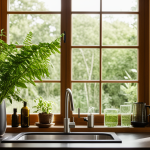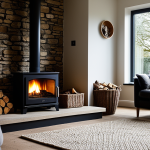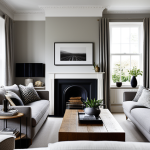Essential Interior Design Mistakes to Avoid in UK Homes
Understanding common interior design mistakes is crucial for creating comfortable, stylish, and functional living spaces in UK homes. One frequent error is neglecting the unique architectural quirks found in many British properties, such as awkward room shapes or limited square footage. This often leads to poor furniture placement where oversized pieces overwhelm smaller rooms, disrupting the spatial flow and making environments feel cramped rather than cozy.
Another key issue lies in disregarding how the UK’s climate influences natural light availability. Many homeowners underestimate the impact of short, overcast days on the ambiance, resulting in interiors that feel gloomy or dull. Failing to employ effective artificial lighting strategies compounds this effect, missing opportunities to brighten spaces with a thoughtful mix of ambient, task, and accent lighting tailored to the home’s layout.
Also to read : How Can You Transform Your UK Home into a Cozy Oasis for the Winter Months?
Colour palettes also pose significant challenges. Hasty or mismatched combinations may clash with the natural light and traditional elements found in UK interiors. Choosing colours that harmonise with both the British climate and the room’s function requires attention to tones that enhance rather than detract from the overall atmosphere.
Storage is another frequently overlooked aspect. UK homes often face space constraints, so without smart storage solutions, clutter accumulates quickly, diminishing both function and style. Integrating clever, unobtrusive storage into the design helps maintain order while preserving aesthetics.
In the same genre : How Can Sustainable Practices Enhance Your Home Living Experience?
Together, these frequent decorating errors highlight the importance of addressing UK-specific conditions early in the design process to avoid compromises in comfort and style. Prioritising spatial awareness, lighting, colour harmony, and practical storage ensures interiors are both beautiful and livable.
Ignoring Natural and Artificial Lighting Constraints
Effective use of lighting is a cornerstone of well-designed interiors, yet one of the most frequent interior design mistakes in UK homes involves neglecting the unique lighting challenges posed by the climate. The UK’s often overcast skies and shorter daylight hours significantly limit natural light, especially in smaller or north-facing rooms. This scarcity can make spaces feel dim, cramped, or uninviting if not addressed appropriately.
A common decorating error is relying solely on natural light without incorporating adequate artificial lighting. Many homeowners either underuse lighting fixtures or choose inappropriate types for the room’s function and layout. For instance, using a single overhead light in a multi-purpose space often results in uneven brightness and shadows, which diminish comfort and usability.
To effectively brighten interiors, consider layering interior lighting by combining ambient, task, and accent lighting. Ambient lighting provides overall illumination, while task lighting targets specific activities like reading or cooking. Accent lighting enhances architectural details or artwork, adding depth and warmth. For example, using wall sconces or LED strips can brighten dark corners in a UK home where natural light barely reaches.
Strategic placement of lighting also matters. Mirrors positioned opposite windows can amplify daylight. Meanwhile, adjustable fixtures enable homeowners to customise the mood and functionality of a room depending on the time of day or activity. Selecting bulbs with a colour temperature that mimics daylight (around 5000K) rather than overly warm tones helps counterbalance the dim natural light typical in many UK residences.
In summary, understanding the UK lighting tips tailored to the country’s weather and room designs is crucial. Thoughtful use of both natural and artificial light will transform interiors, making spaces feel more open, welcoming, and practical despite the climatic constraints.
Overlooking Room Proportions and Furniture Sizing
One of the most frequent interior design mistakes in UK homes comes from misjudging the scale of furniture in relation to room size. Many UK properties have small rooms or awkward layouts, a characteristic that calls for careful space planning UK. Oversized sofas or bulky cabinets can dominate limited space, making rooms feel cluttered and reducing comfort.
In these small rooms, inefficient furniture placement disrupts natural movement paths, causing tension between functionality and aesthetics. For example, placing a large armchair near a narrow doorway can create bottlenecks, while poorly positioned beds or desks might block natural light sources or heating units.
Effective navigation of such layouts requires strategic planning. Prioritising multi-functional or appropriately scaled pieces preserves spatial flow and enhances usability. Slimline furniture, wall-mounted shelves, or fold-away desks suit narrower rooms better than traditional bulky designs. Additionally, using visual cues like light colours and mirrored surfaces supports a sense of openness even when floor space is limited.
In summary, understanding how to balance furniture placement with room dimensions and architectural peculiarities typical to UK homes helps avoid these common decorating errors. This approach ensures comfort and practical use of space without sacrificing style or personal preference.
Clashing or Mismatched Colour Schemes
Choosing the right colours in UK homes is essential but often mishandled, leading to one of the most frequent interior design mistakes. Many homeowners make colour palette mistakes by selecting hues without considering how the UK’s distinctive light and weather conditions influence perception. Overcast skies and reduced natural daylight tend to mute colours, so shades that seem vibrant in a showroom may appear dull or cold once applied indoors.
A common question is, “Why do some colour schemes look off in my British home?” The answer lies in the interaction between paint finishes and the quality of natural light. Glossy or overly bright tones can reflect the limited daylight harshly, while very dark shades might absorb light, making rooms feel smaller and gloomier. To avoid this, choose mid-tone, warm colours or muted hues that complement the softer, diffused light typical of UK interiors.
Harmonising colours creates visual consistency and enhances mood. For example, pairing warm neutrals with soft blues or greens reflects the British landscape while supporting a calming environment. Mixing textures and finishes further avoids flatness; matte walls contrasted with silk cushions or wooden furniture add depth without overwhelming a space.
Other common decorating errors include using too many contrasting colours or ignoring the existing architectural elements like exposed brick or wooden beams, which should influence the palette. Thoughtful combination of tones tailored to the home’s lighting and style respects traditional British design while allowing for modern expressions.
In summary, avoiding clashing or mismatched colours requires deliberate consideration of UK interior colours and how natural light shapes them, thereby achieving harmony that elevates the home’s atmosphere and feels inviting year-round.
Neglecting Storage and Clutter Solutions
In many UK homes, limited space poses a significant challenge, making smart storage an essential component of effective interior design. One of the most common interior design mistakes is overlooking the need for practical storage, which often results in cluttered living areas that detract from both aesthetics and functionality.
Why is storage so critical in UK homes? Many British properties feature compact layouts where every square foot counts. Without well-planned storage solutions, everyday items accumulate on surfaces, reducing usability and visual appeal. This leads to a feeling of disorganisation and stress, undermining the comfort that well-designed spaces should provide.
Effective UK home organisation begins with identifying clutter hotspots, such as entryways, kitchens, and living rooms. Incorporating built-in cupboards, under-stair storage, or bespoke shelving helps optimise these areas without encroaching on valuable floor space. Multifunctional furniture—like ottomans with hidden compartments or beds with drawers—also addresses the needs of smaller rooms by combining storage with usability.
What are practical decluttering tips? Regularly editing belongings to retain only essential items prevents storage systems from becoming overwhelmed. Employing clear containers or labelled baskets streamlines access and maintains order. Additionally, integrating storage solutions that blend seamlessly with existing décor avoids creating a cramped or piecemeal appearance, ensuring style is upheld alongside utility.
Integrating storage thoughtfully also supports the interior’s flow, allowing for smooth movement and enhancing the perception of space. Avoiding bulky standalone units in favour of streamlined, customisable options prevents the common decorating error of overpowering small rooms with inappropriate furniture.
In summary, neglecting smart storage and effective decluttering tips is a prevalent mistake in UK interior design. Addressing these challenges early with tailored solutions not only preserves neatness but also elevates the overall living experience.
Disregarding the Importance of Quality Materials
Choosing appropriate material choices is critical in UK homes to withstand the unique challenges posed by the British climate. A common interior design mistake is selecting fabrics and finishes that lack durability and suitability, leading to premature wear, fading, or damp-related damage. For instance, porous or delicate textiles may absorb moisture readily, which is problematic in environments prone to humidity and occasional dampness.
Balancing cost and quality is essential for long-lasting interiors. While budget constraints might tempt homeowners to opt for cheaper materials, investing in high-quality, durable finishes often proves more economical over time. Materials such as treated wood, moisture-resistant paints, and robust upholstery fabrics adapted for the climate help maintain appearance and function despite frequent use and fluctuating temperatures.
Current material trends suited to British interiors emphasise natural textures that combine resilience with style. For example, wool blends and leather provide both warmth and durability, ideal for colder months. Similarly, matte finishes and textured surfaces not only offer visual interest but also tend to better mask wear and minor imperfections compared to glossy alternatives.
In short, thoughtful selection of quality materials tailored for the UK climate interiors reduces maintenance needs and enhances home comfort. Avoiding the pitfall of disregarding material suitability ensures that interiors remain both beautiful and practical over time.
Failing to Personalise the Space
Personalising a home is vital to avoid one of the common decorating errors seen in UK homes: creating interiors that feel generic or lacking character. What happens when homeowners simply copy current trends? They risk producing spaces that don’t resonate with their lifestyle or preferences, resulting in a disjointed or impersonal atmosphere.
How can one add personal touches home effectively? Start by reflecting on the occupants’ personalities and stories. This could be integrating heirlooms, local art, or bespoke furniture that connects to British heritage. Such choices offer unique focal points and create a sense of belonging that cookie-cutter designs cannot match.
Moreover, understanding British decor style involves balancing tradition with individuality. The UK’s rich architectural history and cultural diversity provide abundant inspiration, but blindly replicating styles without adaptation misses an opportunity to inject personal flair. For example, pairing classic Victorian elements with modern minimalist accents tailors the space to individual tastes while respecting the home’s context.
In practical terms, layering textures, colours, and patterns that speak to personal interests enriches the environment. Incorporate meaningful objects that tell a story rather than filling rooms with generic items. This approach fosters emotional connection and transforms the home into a lived-in sanctuary rather than mere decoration.
Ultimately, avoiding the mistake of neglecting personalisation enhances both comfort and aesthetic appeal. Making design decisions that reflect who you are ensures the home is not just visually appealing but truly yours.
Relying Solely on DIY Without Expert Advice
Many homeowners in UK homes fall into the common decorating error of trusting only their own instincts without seeking interior design help. This approach can inadvertently lead to costly mistakes or an unbalanced final result. So, why is expert insight valuable in interior design?
Professional designers bring specialized knowledge of space planning UK, colour theory, and material suitability, ensuring that choices harmonize with the property’s unique features and climate. They also anticipate potential pitfalls that homeowners might overlook, such as improper lighting placement or poorly scaled furniture. For example, without guidance, one might select a paint tone unsuitable for typically dim British interiors or mishandle clutter solutions for compact spaces.
However, relying solely on experts may feel restrictive to homeowners who enjoy DIY decorating UK projects. The key is to combine personal enthusiasm with professional advice. By consulting experts during critical stages—like layout planning or material selection—owners can preserve creative control while benefiting from tested strategies and technical knowledge.
Finding reliable interior design help in the UK involves researching credentials, viewing portfolios focused on British homes, and interviewing designers to assess compatibility and understanding of regional challenges. Local expertise is particularly important given the distinct architectural quirks and weather-influenced design factors common in UK properties.
In summary, integrating expert insight alongside DIY efforts strengthens outcomes, helping to avoid prevalent interior design mistakes seen in UK households while empowering homeowners to realise their visions with confidence.










